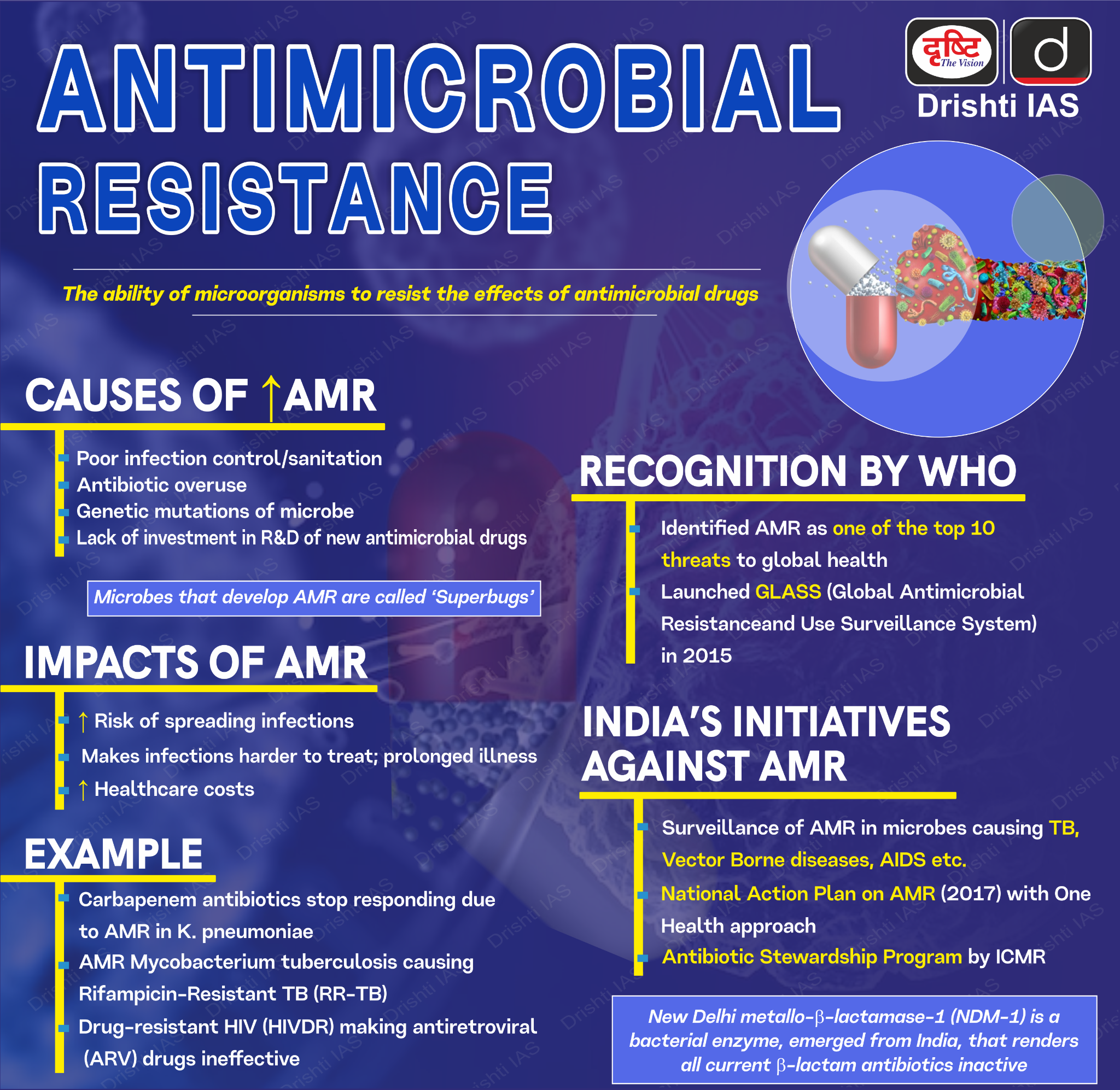Governance
Addressing Antimicrobial Resistance
- 10 Apr 2024
- 7 min read
For Prelims: Global Leaders Group (GLG) on Antimicrobial Resistance (AMR), Antimicrobial Resistance, Food and Agriculture Organization, World Health Organization, One Health Approach
For Mains: Antimicrobial Resistance, Government policies and interventions for development in various sectors and issues arising out of their design and implementation.
Why in News?
Global Leaders Group (GLG) on Antimicrobial Resistance (AMR) released a report titled “Towards specific commitments and action in the response to antimicrobial resistance” ahead of a high-level meeting on AMR to be held at the United Nations General Assembly.
What are the Key Highlights of the Report?
- The GLG report emphasises the need for adequate, predictable, and sustainable financing from domestic and external sources to address AMR, including tackling the dwindling research and development pipeline for new antibiotics.
- The GLG proposes expanding the scope of existing financing instruments to include AMR and increasing investments to support the implementation of multisectoral National Action Plans, especially in low- and middle-income countries.
- The GLG stresses the need for improved quality of data on AMR through surveillance and monitoring and recommends strengthening human resources and infrastructure capacity.
- The GLG proposes the following global targets to catalyse action at the national level:
- Deaths Caused by Bacterial AMR: By 2030, reduce global deaths caused by bacterial AMR by 10%.
- Antibiotic Stewardship and Responsible use in Humans: By 2030, ACCESS group antibiotics comprise at least 80% of overall human antibiotic consumption.
- The ACCESS group antibiotics are a category of antibiotics designated by the World Health Organization (WHO) through their AWaRe classification system.
- Access antibiotics are antibiotics with a narrow spectrum of activity, generally with fewer side-effects, a lower potential for the selection of antimicrobial resistance and lower cost.
- The ACCESS group antibiotics are a category of antibiotics designated by the World Health Organization (WHO) through their AWaRe classification system.
- Antimicrobial use in Agri-food Systems:
- By 2030, reduce the number of antimicrobials used in the agri-food system globally by at least 30-50% from the current level.
- By 2030, eliminate the use of medically important antimicrobials for human medicine in animals for non-veterinary medical purposes, or in crop production and agri-food systems for non phytosanitary purposes.
- Based on these global targets, the GLG recommends that all countries should develop national, outcome-oriented, sector-specific targets with clear goals and timelines, and follow up on their implementation.
Global Leaders Group (GLG) on Antimicrobial Resistance (AMR)
- The GLG on AMR was established in 2020 following the recommendation of the Interagency Coordination Group on AMR (IACG) with the mission to advise on and advocate for political action for the mitigation of drug-resistant infections through responsible and sustainable access to and use of antimicrobials.
- Secretariat support for the GLG is provided by the Quadripartite Joint Secretariat (QJS) on Antimicrobial Resistance, a joint effort by the Quadripartite organisations (the Food and Agriculture Organization of the United Nations (FAO), the United Nations Environment Programme (UNEP), the World Health Organization (WHO), and the World Organisation for Animal Health (WOAH)).
Why is Antimicrobial Resistance a Growing Concern?
- AMR is already a leading cause of death globally, contributing to nearly 5 million deaths annually, with a significant portion occurring in children under the age of five.
- In 2019, bacterial AMR directly caused 1.27 million deaths globally and contributed to 4.95 million deaths.
- Uncontrolled AMR is projected to lower life expectancy and result in unprecedented healthcare costs and economic losses.
- The studies forecast a potential loss of 1.8 years of life expectancy globally by 2035 if stronger responses to AMR are not implemented.
- Without decisive action, AMR is projected to incur substantial economic losses, with estimates suggesting an annual cost of USD 412 billion in additional healthcare expenses and USD 443 billion in lost workforce productivity.
- AMR incurs significant economic costs, with estimates suggesting up to USD 3.4 trillion GDP losses per year by 2030.
What is Antimicrobial Resistance?
- About:
- AMR is a global public health threat that occurs when bacteria, viruses, fungi, and parasites no longer respond to antimicrobial medicines.
- Misuse and overuse of antimicrobials in humans, animals, and plants are primary drivers of drug-resistant pathogens.
- Low- and middle-income countries are disproportionately affected by AMR due to poverty and inequality.
- AMR jeopardises the efficacy of modern medicine, making infections harder to treat and medical procedures riskier.
- Global Initiatives:
- One Health Approach:
- Integrated approach involving human health, animal health, and environmental sectors.
- Aim to achieve optimal health outcomes for people, animals, and ecosystems.
- Global Action Plan (GAP) on Antimicrobial Resistance:
- Adopted during the 2015 World Health Assembly to tackle AMR with a One Health approach.
- Quadripartite Joint Secretariat on Antimicrobial Resistance:
- Collaboration between WHO, FAO, UNEP, and WOAH to coordinate global response.
- High-level Meetings on AMR:
- UNGA resolution established high-level meetings to address AMR.
- World AMR Awareness Week (WAAW):
- Global campaign to raise awareness and promote best practices.
- One Health Approach:
|
Drishti Mains Question: Q. Evaluate the potential consequences of uncontrolled antimicrobial resistance (AMR) on global health and economy. |
UPSC Civil Services Examination, Previous Year Questions (PYQ)
Prelims:
Q. Which of the following are the reasons for the occurrence of multi-drug resistance in microbial pathogens in India? (2019)
- Genetic predisposition of some people
- Taking incorrect doses of antibiotics to cure diseases
- Using antibiotics in livestock farming
- Multiple chronic diseases in some people
Select the correct answer using the code given below.
(a) 1 and 2
(b) 2 and 3 only
(c) 1, 3 and 4
(d) 2, 3 and 4
Ans: (b)
Mains:
Q. Can overuse and free availability of antibiotics without Doctor’s prescription, be contributors to the emergence of drug-resistant diseasesin India? What are the available mechanisms for monitoring and control? Critically discuss the various issues involved. (2014)







